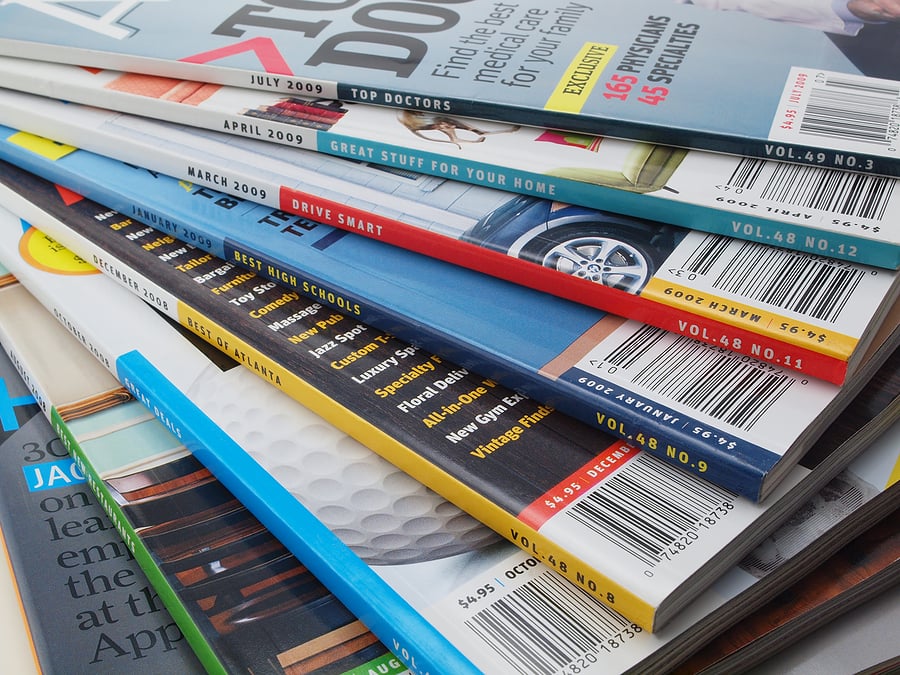
But you’re just a little old blogger, right?
Why would popular magazines like Forbes, WebMD, and Redbook be interested in you?
You might be surprised.
Thousands of magazines appear on the newsstands and in readers’ mailboxes every month, and they’re constantly on the lookout for new writing talent. Yes, your audience as a blogger may still be small, but all those hours you spent slaving away on your content has probably honed your writing skills to where you could, in fact, compete with the big boys and girls to write for magazines.
And it’s SO worth it.
If you’ve been blogging for a while, let’s talk about why you should be interested in magazines:
1. They can send you a lot of traffic.
Most magazines that pay well for freelance writing also command a huge readership.
For example, when I wrote for Woman’s Day, they had 6 million readers all across the United States. That’s a lot of eyeballs reading your work.
Of course, the size of the audience isn’t everything. Sometimes you’re looking for a smaller but more targeted audience. Magazines can help you there, too!
For example, if you want readers in a particular geographic area, you can write for local magazines that boast followings in that area. If you want readers from a particular industry, you can write for trade publications devoted to that field. If you want readers who buy a particular product or service, you could write for custom publications reaching those customers.
The important point:
Magazine readers are an entirely different audience than the people surfing the blogosphere. These readers are all people who might never find out about you outside of their favorite magazines.
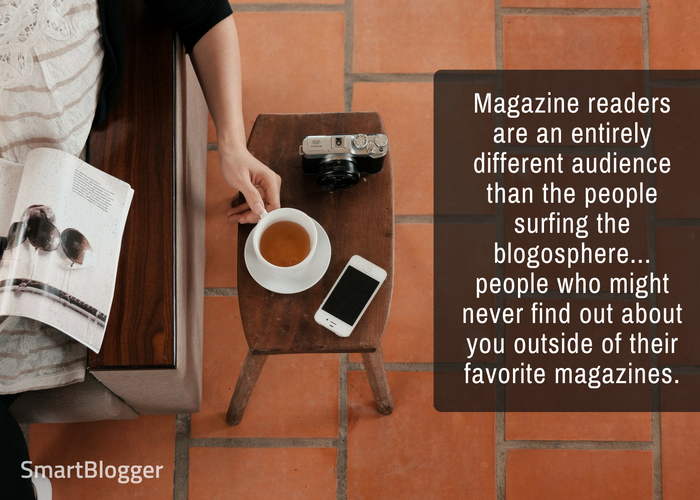
Even better, many publications, especially online ones, run a bio box at the end of your article where you can trumpet your credentials and lead people to your blog. Writer’s Digest gave me a bio box at the bottom of my column in every issue when I wrote their Conference Scene column, and it drew interested readers online to find out more about my books and classes for writers.
2. They can be lucrative gigs.
Some magazines don’t pay anything at all… but some pay big. (Hint: Those are the ones you want to write for.)
I’ve earned anywhere from $.10 per word writing for trade magazines at the beginning of my career up to $2.50 per word penning articles for national consumer magazines like Health. What’s important, though, isn’t the per-word rate — it’s your hourly rate, and I usually earn $250 per hour at this kind of work even at magazines that pay just $.50/word.
So, you’re not just connecting with new readers. You’re getting paid to connect with new readers.
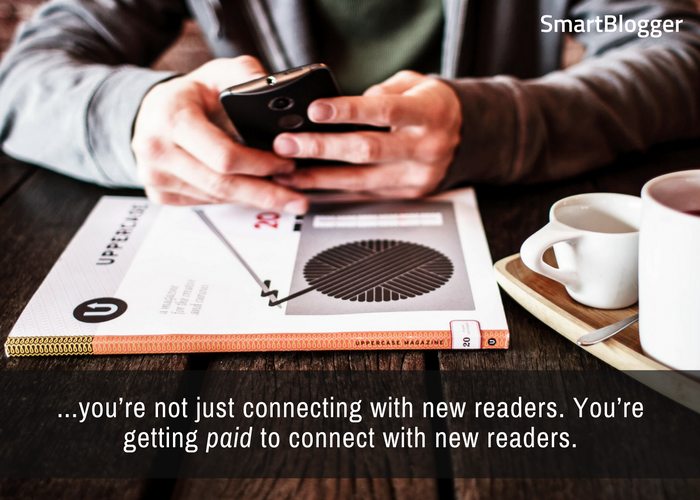
How cool is that?
3. They can help you land other well-paying gigs.
You can use published articles as clips, or samples, to show to potential clients in all writing areas. Copywriting clients, for example, like to know you understand the ins and outs of journalism and have the skills to weave a narrative and tell a good story. Just what they want you to do with their products!
Your article writing can also turn into speaking gigs. If a conference organizer likes one of your articles in their industry trade pub, they might ask you to turn your article into a speech, giving you not only more exposure, but a nice speaking fee too! One of my very first articles, in a national business magazine, led to a speaking opportunity at a Chamber of Commerce in Pennsylvania.
Plus, let’s not forget about credibility. If you’re on the hunt for a book deal, a business partner, or an affiliate, who do you think they’re going to want to work with: the person with no creds, or the one with a column in a major magazine? Yeah, it’s a no-brainer.
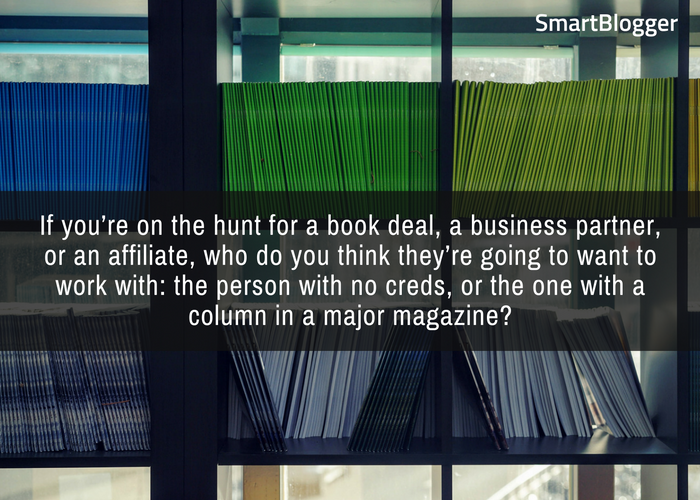
Traffic, money, credibility – you’re sold, right? Now you’re itching to learn how to get started.
Luckily, as a blogger, you’re one step ahead of the game, because just as you can use magazine articles as clips to get blogging gigs, you can use blog posts as clips to land article assignments.
Who wants to buy my articles?
You already know about the big magazines that populate the newsstand, so let me share two super-secret markets out there for writers:
TRADE MAGAZINES: LITTLE BUT LUCRATIVE
Trade magazines are business-to-business publications created for members of a certain industry.
For example, I’ve written for Pizza Today, The Federal Credit Union, In-Plant Graphics, Sign Builders Illustrated, Restaurant Management, and Mini-Storage Messenger. These magazines tell readers how to best manage, market, and generally boost the success of their businesses.
There are gazillions of these magazines, covering every imaginable market niche. For example, my husband once wrote for Indian Gaming Business — and this magazine actually has a competitor. So whatever educational or professional background you have, you can probably parlay that into trade assignments.
The downside?
Don’t expect to get rich. At least, not right away.
Trade magazines typically pay less than consumer magazines — think 10 – 50 cents per word, though many pay higher — but on the “pro” side, they’re easier to write for than the big guys, they tend to pay quickly, and they become loyal clients that will come back to you again and again. Also, once you get the hang of writing for a particular industry, you’ll be able to complete assignments more quickly, meaning your hourly rate will increase.
Find trades in Writer’s Market and at WebWire. Webwire doesn’t include links to the magazines, but you can search for the sites of pubs you’re interested in on Google.
CUSTOM PUBLICATIONS: ALL THE BRANDS YOU TRUST
A custom publication is a magazine that serves as a marketing piece for a business to give to its customers or clients.
Many of these are published by companies called custom publishers (though many of them now call themselves content companies). That means the business distributing the magazine to its clients is not the actual publisher. The business pays the publisher to create the magazine for them.
So, that magazine you get at Sam’s Club? Custom published.
The one you get from your bank, supermarket, or insurance agency? Most likely also custom published.
And the even cooler part?
Custom published magazines tend to pay more than trades — in my experience, at least 50 cents to $1 per word. Yes, you do need some writing skill to freelance for them, but not really any more or less than you need for consumer and trade magazines.
If you’re good, you can also get steady work. As with trades, if custom pub editors like you they’ll add you to their “stable” of writers to hand out assignments to. Sweet!
Find custom publications at The Content Council. Click on “Members” and you can search by industry to see who publishes magazines (and other content) in sectors like health, retail, and financial services.
Writing a Kick-Ass Query
To break into most magazines, you need a query letter, also known as a pitch. It’s basically a sales letter telling the editor what your idea is, why it’s important to readers, and why you’re the best person to write it.
Here’s what you’ll need:
A FANTABULOUS IDEA.
Read over your target magazine to help you brainstorm ideas. If you can’t find physical copies of the magazine, check out their online archives. Sometimes the content differs, but you’ll get a good idea of what the magazine runs.
A word of warning:
Most of the ideas that first pop out of your head will suck. Even if you think they’re great, they’ll probably suck. (Sorry.)

That’s because we tend to think in terms of topics, not story ideas. A topic is a broad idea that could really be a book, and has probably been done already, in some form, in both books and magazines. A story, on the other hand, has your own unique angle or slant that a jaded editor hopefully hasn’t seen before. For example:
Topic: How to stay healthy this summer. (See how that could be a book?)
Story: Summer bummers: The top 5 health snafus that can ruin your summer, and how to solve them.
Story: How to stay healthy this summer with items you already have in your pantry.
Story: Special precautions people with condition X need to take to stay healthy during the summer.
Get the idea?
Great. Let’s jump into the next most important part of a great query:
A SUPER-AWESOME LEDE
A lede (yes, that’s spelled right) is the first paragraph or two of your query, and it’s typically written in the same style as the ledes you see in articles in your target magazine. So you might start with an anecdote, a compelling quote, a startling stat — or you may do something more literary in style.
Here are a couple of potential ledes for the “Summer Bummers” idea above.
When McKenzie Smith, 32, went to the beach last summer, she envisioned lying around on the sand reading a romance novel while her kids played in the warm waves.
What she didn’t envision was developing an itchy condition called sea bather’s eruption, which is caused by stings from tiny, larval jellyfish.
Beset by bug bites? Feeling sick from a summer picnic? You’re not alone. According to a new study by the National Institutes of Health, nearly one-third of Americans over the age of 18 have to miss work each summer due to seasonal snafus like these — and other recent research has found that 45% of us avoid going outside in the summer because we’re afraid of bee stings, poison ivy, and sunburn. [Note: I totally made those stats up.]
A NUT GRAF
I know — what’s with all the funny spellings, right?
The nut graf is the paragraph right after the lede where you quickly summarize what you’ll be offering. For example, let’s take my stat lede above and add on a nut graf:
Summer doesn’t have to be that way. In my article “Summer Bummers,” I’ll interview top docs to give your readers solid, little-known advice on how to combat the top seven seasonal health woes: poison ivy, dehydration, food poisoning, sunburn, sea bather’s eruption, bug bites, and heat rash.
See?
It’s the point in your query letter where you pivot from the idea into your actual pitch. The transition should be smooth, the lede flowing right into the nut graf, just like the one above.
Next, we need…
A BODACIOUS BODY
The body is where you get into the nuts and bolts of your pitch. You don’t want to make the editor guess at what you’re offering: Give her some examples, written in the style you’d write the article in.
And yes, that means you’ll have to do your homework. Probably more than you’re used to.
Most blogs are opinion-based: You write what you think, and nobody is looking over your shoulder, expecting you to back it up. Magazines, on the other hand, are evidence-based. Unless you’re an expert writing an opinion piece, editors will expect you to show supporting evidence.
Sometimes, that means conducting a couple of quickie pre-interviews. You can find potential sources to interview at universities, organizations, and think tanks, and on LinkedIn, online forums, Twitter, Facebook, and source-finding sites like ProfNet. And don’t discount the value of your email list!
So here’s the body of the query I started above.
* Food Poisoning
If you downed questionable shrimp salad at the office picnic, you may find yourself faced with nausea, vomiting, and diarrhea. “One thing you shouldn’t do is take an anti-diarrheal medicine, because the diarrhea carries the toxins that are making you sick out of your system,” says Daniel Jones, MD, an associate professor at Harvard School of Medicine. Instead, sip a sports drink, which helps replace the electrolytes you’re losing. Until you feel better, avoid solid food and drink your usual liquids plus a quart of sports drink per day.
* Dehydration
The bad thing about dehydration isn’t that your mouth is parched and you crave Frappuccinos– it’s that dehydration can lead to heat exhaustion, which can in turn lead to heat stroke. The worst-case heat stroke scenario is that your blood pressure drops dangerously, resulting in organ damage.
Here’s advice from Liz Johnson, MD, a physician at The Wellness Institute in Boston: If you notice decreased sweating, lightheadedness, or dizziness, get to a cool place and rehydrate with a sports drink. Anticipate and head off the problem by deep-sixing the caffeine, which can make you sweat more and therefore lose more water, and drinking more than usual if you plan to be out in the heat or if you take a diuretic such as blood pressure medication.
Don’t skimp on your research! This is where you prove to a skittish editor that you do indeed have the goods.
Then and only then can you…
BRAG ON YOURSELF
My writer friend Kelly James-Enger calls this the “why I’m so great” paragraph. This is where you tell the editor why you are the best person to write the proposed article. So if I were 100% a blogger and had never written for magazines, I might write:
Even if you don’t have a lot of writing credits to toot your horn about, there are other brag-worthy things you can use — like a deep personal knowledge of the topic (your spouse is a doc? mention that here!), an educational background in the topic, or exclusive access to a key source.
You’re a writer, so spin what you do have into the best possible light!
A CLOSING
In the closing of the pitch, I usually do two things:
1. Show I understand the magazine’s readership.
Explain why your article will be important to the magazine’s readers. For example:
2. Ask for the sale.
One mistake many writers make is they forget to wrap up in a clear way by asking for an assignment. They let the pitch simply peter out, and leave the editor wondering why the writer bothered.
You can ask for the sale in a lot of ways: “I look forward to hearing what you think about my idea for Magazine X!” “I look forward to your reaction.” “Does this idea sound interesting to you?” “May I write this article for you?”
And that’s it! You’re finished!
What’s Next?
Send your query letter via email directly to whichever editor you think would handle your topic.
At big magazines, that is often a senior, deputy, or associate editor. At smaller magazines, like many trades, you can pitch directly to the editor.
Can’t decide? Give them a call and ask.
To find the editor’s email address, first search the website, and try Google searches on the editor’s name and “contact.” You can also search for the editor on LinkedIn; sometimes you’ll find an e-mail address right on the editor’s profile.
If those tactics come up short, try calling the magazine. Don’t be afraid! I promise no one will yell at you.
As a last resort, try to decipher the magazine’s email format (it’s often on the Ad Sales page) and use that to figure out your editor’s address. You can take advantage of one of the many free online email verification systems like Verify-Email.org to determine if the address you guessed at is correct. This isn’t foolproof, but it helps.
Once you zap off your query, don’t just wait with bated breath for a reply, because it can take a loooong time. Send your pitch to other magazines as well (you may need to tweak your pitch a bit for each one), and get to work on your next query. Pitching a numbers game, and it’s all about volume.
Keep pitching…
Once you learn to write a query, you’ll get better and better at it, and the process will take less and less time. You’ll start to develop relationships with editors — yes, even a nice rejection asking you to pitch again can be the start of a beautiful (and lucrative) friendship. And some of those relationships will lead to regular gigs.
But you have to keep pitching.
Too many talented writers fire off a query or two and then quit. Maybe the rejection is too painful, or maybe you’re just too busy.
Regardless, the writers who make it are the ones who send a lot of pitches. Preferably at least one or two a week — with each of those going out to multiple publications — at least for the first few years.
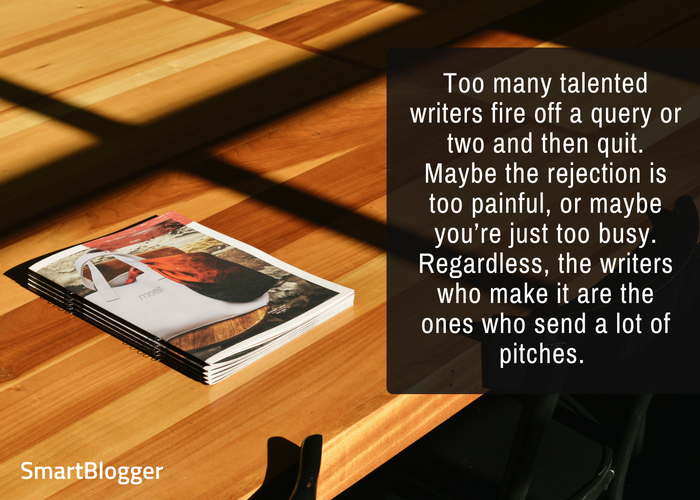
Here’s why:
You have to do the work to write for magazines
Writing for magazines is the same as anything else. You have to do the work.
At first, you suck. Then it gets a little easier. Then one day you look at your work and realize you actually know what you’re doing! Heck, when I started out as a full-time freelancer in 1997, I would print out each pitch, go over it with a red pen, have my writer husband go over it with a red pen, enter in the edits, and repeat the process until the pitch was as clean and perfect as possible. These days, I can write a full pitch in under an hour.
You just have to keep going. You have to keep writing. You have to trust it’ll all pay off
It’s certainly paid off for me, and I believe it can pay off for you too. Not only through money, although that’s certainly nice, but through connecting with people who need your wisdom.
The world is full of people with questions who aren’t searching blogs for answers. To help them, you have to reach outside of your medium and connect with them where they already are.
You have the skills. You have the passion. You now have the step-by-step plan to make it happen.
So get out there and start writing!
There’s a whole other world waiting for you, and if you’re willing to put in the work, you’ll do just fine.
from
http://redirect.viglink.com?u=https%3A%2F%2Fsmartblogger.com%2Fwrite-for-magazines%2F&key=ddaed8f51db7bb1330a6f6de768a69b8
No comments:
Post a Comment